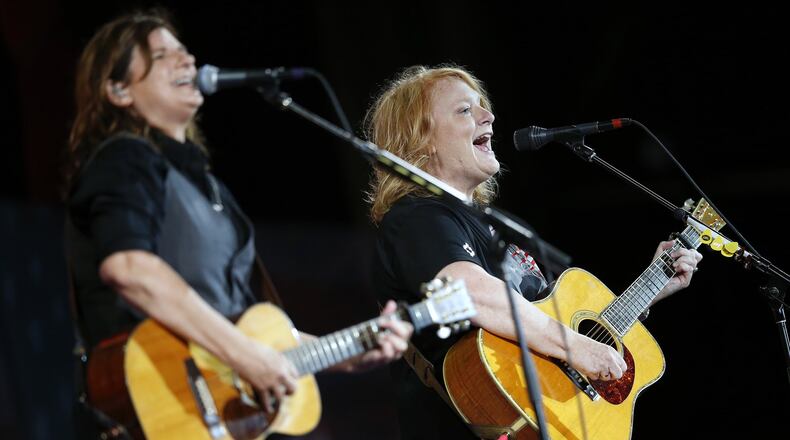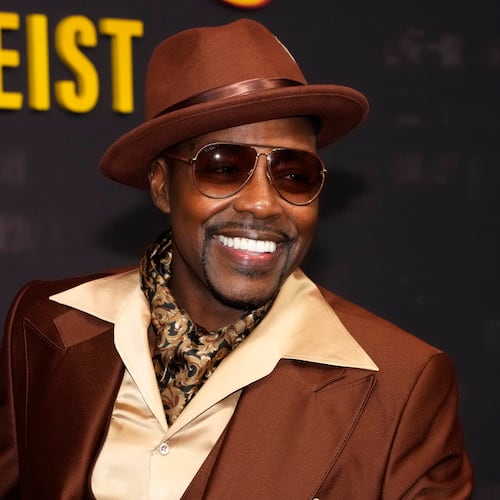After more than 35 years since performing in bars around Emory University, the Indigo Girls remain one of the most consistent musical treasures in folk-pop.
The duo of Emily Saliers and Amy Ray are not only durable songwriters and musicians but the kind of people whose activism – whether to support LGBTQ rights, Native American communities or environmental causes – is practiced even more than it’s preached.
On May 22, the pair will release their 16th album, “Look Long,” a visceral collection of 11 songs that alternates among the lush melancholia of the title track, B-52s-esque quirkiness (“Favorite Flavor”) and aching introspection (“Country Radio”). Ray and Saliers enlisted old pal John Reynolds – who steered 1999’s “Come on Now Social” – for production duties and gathered with him and longtime musician friends in Bath, England, to record in January 2019.
Though plans to support the album with a summer tour have obviously changed, the Indigo Girls have remained deeply connected to their devoted fans via a series of livestreams. Their May 14 edition – shown on their Facebook and Instagram pages – raised $230,000 for Honor the Earth, their non-profit dedicated to Indigenous environmental justice and green energy solutions. And on May 21, another (all-request) live outing and Q&A session will raise money for food banks in Georgia through Feeding the Valley. (Stacey Abrams is expected to appear for a message.)
The Indigo Girls’ extensive career will also be the topic of feature documentary from director Alexandria Bombach (“On Her Shoulders”), marking the first time they’ve allowed a film director to follow their creative process.
RELATED>>Mic Check: The Indigo Girls talk about homeschooling and life during quarantine
Talking a few weeks ago from their respective quarantine spaces – Ray at her home in north Georgia and Saliers from the west coast of Florida – the duo shared some insights about their new music and how they’re staying optimistic.
Q: I know record sales haven’t been something that’s fueled you in a long time. But how do you feel getting ready to release an album with the prospect of touring behind it looking bleak?
Ray: I feel like one of the things that has helped us together is that we tend to work with what we have. We are sort of flexible that way, probably because we started when we were so young and played a lot of gigs. We're both like, we don't know when or how we're going to tour, but we're excited about the new record, and we're trying to make the most of whatever tools we have. The thing that works for us is that we have a fan base that is so amazing and engaged with each other and with us. It gives us that really great gift that we can put music out, and people in our fan community will listen to it. I don't know if we'll sell a lot of records, but I know we have a great fan base who will give us feedback, and we'll stay engaged in some. Right now, it's not going to help us any to freak out about the future.
Saliers: When it ever returns to normal — and I believe it will — people will come to concerts again and go to shows. I feel that's going to be an incredible moment when we can do that again. Playing live shows is at the center of who we were, and I believe it will be a glorious reuniting. But we still enjoy playing these livestreams, and we're enjoying being alive in the music. I'm not freaking out about the future; there's no kind of pressure about where our album is charting.
Q: Bath is such a beautiful, secluded little town. What was that environment like to record in? Did being in Peter Gabriel’s (Real World) studio lend any kind of vibe?
Ray: The good thing about that vibe is because of all the people who have worked there. You have communal breakfast, lunch and dinner, and you live there, so there's a certain focus that you get to have. We didn't stray that far; we didn't have time to. … We went to a little village pub one night, but we kind of just stayed in the complex, and it was cold and rainy, and we had tea all the time.That band we made the record with is super important to us. We met them in 1998 on Lilith Fair. Just having them all together in one place was totally great. … (Keyboardist) Carol (Isaacs) and (bassist) Clare (Kenny) played off and on with us for years… and we were visiting when playing in England a couple of years ago, we said, let's make a record again.
Q: What’s the story behind album cover photo (of Ray and Saliers as children)?
Ray: We had an artist friend, and she does these cool collage things, and she said, "Send me a bunch of pictures of yourself." We both ended up sending her pictures with an Easter shot from around the same age. I think I was 8.
Saliers: I was probably 5 or 6. I think that was the last year I wore an Easter dress before my mom made me Easter pants (laughs).
Q: Tell me about “When We Were Writers.” It starts as a nostalgic look back, but you conclude that “you will never be finished.” What prompted that thought cycle?
Saliers: I get a lot of fodder from my two years at Tulane (University, which she attended before transferring to Emory). Those life experiences were extremely visceral in colors and tastes. I remember we used to have quarter beer days on the Quad and the Radiators and the Neville's (performed). My world was exploding. I had never been away from my parents. I thought about that feeling of writing songs back then and having your world open up and my sexuality and the vibrancy of that time. Things that were frightening, but those are all things that go into my songwriting. But ultimately, my day in the sun, what does that mean? The point being, it's still burning inside. It might be different, but that fire is still there.
Q: Who or what inspired “Country Radio”? It’s so sweet, yet melancholy.
Saliers: That I wrote about because I love country music and was driving back and forth to Nashville a lot, and I love that drive, and I was listening to a lot of country and thinking of all of those hetero-normal songs that I couldn't quite place into my own life. That goes back a long, long, way. It's sad, too.
And by contrast, “Howl at the Moon” is filled with this spirit of fun and abandon.
Ray: We came into the studio and John (Reynolds) had created this whole beat with samples. It turned into a great feel. The song is about liberation and freeing yourself — and that's what the music feels like to me.
About the Author
Keep Reading
The Latest
Featured







